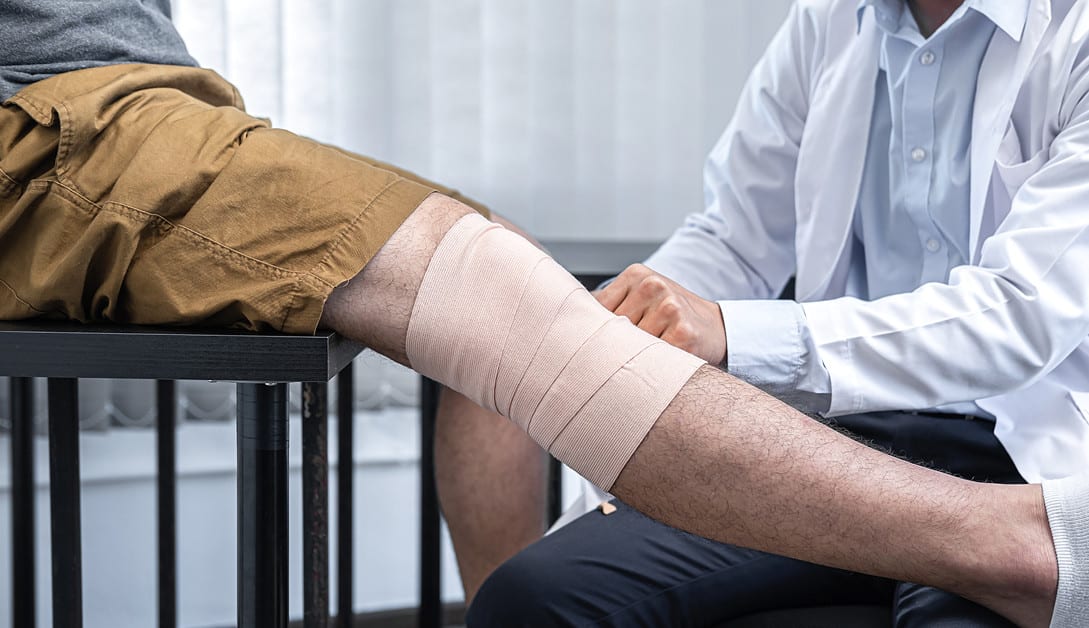Introduction
Knee pain can be a real struggle for many. Exercises that are done properly can help ease pain and avoid future issues. Overweight people or those with mobility issues must take extra measures when exercising. This guide provides tips for those who want to stay fit while managing their physical limitations.
You need to understand how muscle imbalances cause knee pain. Certain exercises can help strengthen the muscles around the knees. You can create a safe and effective routine. Incorporate strength training, use correct form, use weight-bearing machines, and focus on low-impact aerobic activities. This way, you can prevent knee pain and get the best results.
Causes of Knee Pain
Overweight people often experience knee pain. The source? Too much strain. Improper form and technique, overuse of the knees, and weak muscles may be factors. Age, activity level, and type of exercise can also contribute.
In this article, we’ll cover causes of knee pain and share tips to help overweight individuals avoid it:
Excess Weight
Excess weight is a huge factor in knee pain. This is especially true for people who are overweight or obese. Each pound adds three times the pressure when walking, making it hard to keep proper form during exercise. It also wears down joint cartilage, which can’t protect the joint as well.
To avoid or lessen knee pain from excess weight, individuals should aim for a healthy body weight through diet and exercise. They should also do exercises that target the muscles around the knee, so they can support the joints when doing strenuous activities. Squats and walking lunges are great options for strengthening the legs while protecting the joints.
Weak Muscles
Weak muscles can cause knee pain during exercise. This is because the weak muscles can lead to misalignment of the knee. With weak muscles in the legs, there is a higher risk of injury and instability.
To prevent knee pain during activity, those who are overweight should focus on strengthening their leg muscles such as the quadriceps (thigh), hamstring (back of thigh) and calf. This helps with balance and proper form during exercise. Resistance training should be done carefully if there are injuries or joint concerns.
Low-impact activities can be done to increase leg muscle strength such as:
- Using exercise machines like stationary bikes.
- Swimming is a good option since it puts little strain on the joints and also helps increase muscle tone and burn calories.
Poor Posture
Poor posture can cause knee pain, and overweight people are especially vulnerable. To reduce knee pain, practice proper posture and exercise.
- Stand against a wall, with feet 15 inches from it. Make sure your neck is relaxed and shoulder blades are squeezed for 3 seconds.
- Exercising several times a day helps correct posture.
- To reduce the load on your knees, lose excess weight. Try low-impact exercises like swimming or the elliptical. This will help burn calories and prevent more knee pain.
Inadequate Warm-up
Poor warm-up can cause knee injuries and pain for overweight individuals. Thus, it is essential to begin with dynamic stretching for five mins. Dynamic stretches involve gentle movements that engage multiple muscle groups. It helps increase blood flow, allowing better movement and reducing joint stress.
Hip rotations and leg swings can also improve flexibility and balance. Furthermore, wearing appropriate footwear will provide cushioning for joints, avoiding excessive pressure when engaging in activities of higher intensity.
Prevention Strategies
Overweight individuals are more prone to experience knee pain during exercise. So, it is essential to take precautionary measures to prevent such an occurrence. Here are some tips overweight people can use to safeguard their knees when exercising:
- Choose low-impact exercises such as swimming, cycling, and walking.
- Warm up before each exercise session.
- Avoid activities that require a lot of jumping and running.
- Wear supportive shoes with good cushioning.
- Strengthen the muscles around the knees with strength training.
- Stretch after each exercise session.
Exercise Properly
Exercising correctly is key for avoiding knee pain when working out, particularly if you are overweight. It’s essential to work within your physical capabilities and progress gradually. For an overweight person starting an exercise program, low-impact exercises like walking and swimming are highly recommended, as they put less pressure on the knees.
Furthermore, it’s important to use good body mechanics while exercising. Proper posture and alignment can help to exercise safely and avoid knee pain. Do activities that use more of your own bodyweight without weights; for example, squats or lunges. Before exercising, warming up can also reduce the chance of knee pain by reducing the risk of muscle tears and other injuries due to overuse or inadequate stretching. After each workout, individuals should cool down too; stretching out the muscles helps with relaxation and healing from activity.
Strengthen Muscles
Strengthening the muscles around your knee can better stability and reduce pain. Quadriceps (thigh muscle) weakness is the most common cause of knee pain in those who are overweight or obese. Strengthening the quadriceps will help improve your position while exercising and give more knee support.
Focus on exercises that strengthen the quadriceps, like squats, bridges, lunges, leg curls and calf raises. Do two to three sets of each exercise, 10 repetitions per set. Start with lower weights or body weight, then gradually raise intensity as you become stronger. Concentrate on keeping the right form during each exercise, to ensure the right muscles are used and no imbalances are formed.
Stability exercises like single leg balances, hip abductions (side leg lifts) and leg presses can also help improve stability around the knee joint. They activate smaller stabilizing muscles in your hip area which may be weak or underactive due to lack of activity or incorrect movement patterns that cause further injury. Do 10 repetitions per side and focus on balance, not speed for the best results.
Working with a physiotherapist or PT can help make sure you do the exercises with the correct form. It’ll also go through all necessary steps in building strength before activities like running or jumping sports, so you reduce the risk of reinjury from overuse during exercise activities.
Use Proper Posture
When exercising, proper posture is key. Keep your abs slightly engaged and ears in line with your shoulders. When squatting or lunging, your body weight should be evenly distributed on both feet. Don’t let your legs be too close or too far apart. Additionally, don’t let your knee bend more than 90 degrees when you move forward. Doing this can cause pain and stress to the knees.
Wear Proper Footwear
The correct shoes can change everything when it comes to avoiding knee pain while exercising. Running, walking and hiking need supportive shoes to reduce stress on the knees. Look for shoes with cushioning and arch support to absorb shock, especially during intense activities like running or basketball.
For best results, replace your exercise shoes every six months or sooner if they no longer provide support. If you’re uncertain, an orthopedic specialist could be helpful. They will ask you questions about your exercise routine and suggest shoes based on your answers.
It is also important to think about possible foot problems that can cause knee pain during exercise. Flat feet can lead to inward rolling of the knees during weight bearing activities such as jogging or climbing stairs; motion control shoes can help by controlling pronation and ankle movement. Orthotic inserts can adjust feet alignment and reduce pressure on knees, plus give extra cushioning for better shock absorption.
Stretch Before Exercising
Dynamic stretching is important before exercise. It uses quick movements to target key muscle groups. Examples: leg swings, walking lunges.
Static stretching is also important. It involves holding a stretch for 30-60 seconds. Examples: standing quadriceps stretch, hamstring stretch, gluteal stretch, hip flexor stretch.
Dynamic and static stretching can help reduce muscle tightness around the knee. This can reduce knee pain and increase comfort during exercise. It makes physical activity safe for those who are overweight.
Conclusion
To keep your knees healthy during exercise, do activities that support joint function and muscle strength. Examples are: brisk walking, swimming, and cycling. Additionally, include exercises to strengthen the muscles around your knees, like squats and lunges.
Moreover, pay attention to your body posture while exercising. Finally, stay hydrated and get enough rest between workouts.
With these tips, you can keep enjoying physical activity without any knee pain.
Frequently Asked Questions
Q1: What are the best exercises for overweight individuals to prevent knee pain?
A1: The best exercises for overweight individuals to prevent knee pain are low-impact aerobic activities such as walking, swimming, and cycling. Strengthening exercises such as squats and step-ups can also help to improve knee stability and reduce the risk of injury.
Q2: Are there any tips for knee pain prevention during exercise?
A2: Yes, there are a few tips for knee pain prevention during exercise. Make sure to warm up properly before any activity and to wear supportive shoes. Do not exercise if you are in pain. Build up the intensity and duration of exercise gradually. Finally, always stretch after exercise.
Q3: What should I do if I experience knee pain during exercise?
A3: If you experience knee pain during exercise, stop immediately and rest. Ice the area to reduce swelling and take anti-inflammatory medication if needed. If pain persists, contact your healthcare provider.





